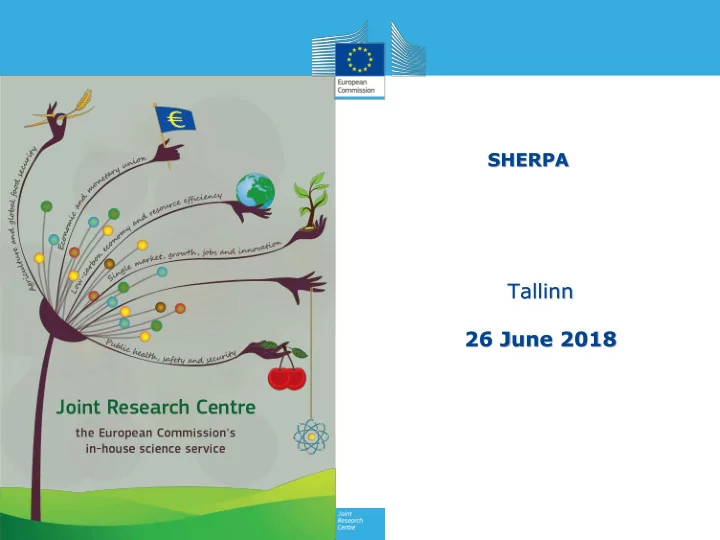

SHERPA Tallinn 26 June 2018
SHERPA in the overall context Visualisation & Interpretation Aim : quantify the sectoral and/or spatial origins of pollution NH 4 SHERPA NH 3 Tagging approach CTM Incremental Mass transfer - SA Input (model, emissions, meteorology, city, resolution…)
Example: Stockholm PM2.5 Urban air quality Atlas, 2017. Based on SHERPA Segersson et al. 2017 : Health Impact of PM10, PM2.5 and Black Carbon Exposure Due to Different Source Sectors in Stockholm, Gothenburg and Umea, Sweden 3
Example: Stockholm SHERPA spatial variablity in source allocation Atlas location one cell south 4
Test case: Stockholm Atlas 1. Assumption 1: only primary emissions have a local impact 2. Assumption 2: LPS only have impacts 3. Visualization in terms of population exposure 5
Test case: Stockholm Visualization: population exposure Industry Residential Local vs. Regional Transport 6
SHERPA formulation, uncertainties and methodological approach Visualisation (average population exposure vs. local concentration) Aim : identify & quantify the sectoral and/or spatial origins of pollution Segersson et al. approach Gaussian high resolution modelling SHERPA Only primary emissions have a local impact • Incremental approach • CTM Treatment of point sources Input (model resolution , emissions , meteorology, city…)
SHERPA in the overall context Visualisation & Interpretation Aim : identify & quantify the sectoral and/or spatial origins of pollution NH 4 SHERPA NH 3 Tagging approach CTM Incremental Mass transfer - SA Input (model, emissions, meteorology, city, resolution…)
Uncertainties of the SHERPA input data Sectors (Transport-Industry-Residential-Agriculture SHERPA SHERPA Areas Areas (City-country-EU) (city-FUA-National-International) 9 CHIMERE EMEP Emissions Emissions Meteorology Meteorology Base year Base year Resolution Resolution
SHERPA in the overall context Visualisation & Interpretation Aim : identify & quantify the sectoral and/or spatial origins of pollution NH 4 SHERPA NH 3 Tagging approach CTM Incremental Mass transfer - SA Input (model, emissions, meteorology, city, resolution…)
SHERPA formulation & evaluation SHERPA CHIMERE
SHERPA formulation, uncertainties and methodological approach Concent entrat atio ion vs. expos posure: ure: industry stry << fac 2 or 3 Visualisation & Interpretation Aim : identify & quantify the sectoral and/or spatial origins of pollution NH 4 Urban an Agri Bias << << SHERPA << << 5-10 10% NH 3 30-50 30 50% Fac 2 or 3 Tagging approach CTM Incremental Mass transfer - SA Possib sible le change ges in prior orities ities Input (model, emissions, meteorology, city, resolution…)
SHERPA survey SHERPA SURVEY Interpretation of results Result Better documentation Speed Exporting formats More validation linearity emissions/concentrations SHERPA Mountain areas, background Treatment of point sources Assumptions Limited to screening at country level Too coarse resolution for urban More validation (CTM, emissions) Geographical coverage CTM Inaccuracy in emission inventory Choice of CTM model Use of own emission inventory Input
14
Recommend
More recommend